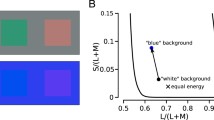Abstract
Data for densities and sizes of human cones were analyzed as a function of retinal eccentricity. Density of cones followed a decreasing power of about -2/3 over much of the eccentricity range. This decrease, and the subsequent increase in cone density toward the ora serrata, were predictable on the basis of a hypothetical density-control mechanism to equate the integrated luminous flux at the photoreceptors per unit retinal area, together with the empirical rule that cone diameter increases with a power of about 1/3 with eccentricity beyond the foveola. The analysis implies that cones aggregate in inverse proportion to the light impinging on them, and provides an explanation for the pronounced increase to 100% cone density at the ora serrata.
Access this chapter
Tax calculation will be finalised at checkout
Purchases are for personal use only
Preview
Unable to display preview. Download preview PDF.
Similar content being viewed by others
References
Oesterberg GA. Topography of the layer of rods and cones in the human retina. Acta Ophthal Suppl VI 1935.
Curcio CA, Sloan KR, Packer O, Hendrickson AE, Kalina RE. Distribution of cones in human and monkey retina: Individual variability and radial asymmetry. Science 1987;236:579–582.
Schein S. J. Anatomy of macaque fovea and spatial densities of neurons in foveal representation. J Comp Neurol 1988;269:479–505.
Williams RW. The human retina has a cone-enriched rim. Vis Neurosci 1991;6:403–406.
Spring KH, Stiles WS. Apparent shape and size of the pupil viewed obliquely. Br J Ophth 1948;32:347–354.
Jay BS. Effective pupillary area at varying perimetric angles. Vision Res 1962;1:418–424.
Drasdo N, Fowler CW. Non-linear projection of the retinal image in a wide-angle schematic ai]eye. Br J Ophth 1974; 58:709–714.
Polyak S. The retina. Chicago: University of Chicago Press 1941.
Laties Am, Liebmann PA, Campbell CEM. Photoreceptor orientation in the primate eye. Nature 1968;218:172–173.
Charman WN. The retinal image in the human eye. In: Osborne NN, Chader GJ, editors. Progress in retinal research. Oxford: Pergamon Press, 1983: 1–50.
Tyler CW. Analysis of visual modulation sensitivity II. Peripheral retina and the role of photoreceptor dimensions. J Opt Soc Am A 1985;2:393–398.
Lotmar W. Theoretical eye model with aspherics. J Opt Soc Am 1971;61:1522–1529.
Author information
Authors and Affiliations
Editor information
Editors and Affiliations
Rights and permissions
Copyright information
© 1997 Springer Science+Business Media Dordrecht
About this chapter
Cite this chapter
Tyler, C.W. (1997). Analysis of Human Receptor Density. In: Lakshminarayanan, V. (eds) Basic and Clinical Applications of Vision Science. Documenta Ophthalmologica Proceedings Series, vol 60. Springer, Dordrecht. https://doi.org/10.1007/978-94-011-5698-1_7
Download citation
DOI: https://doi.org/10.1007/978-94-011-5698-1_7
Publisher Name: Springer, Dordrecht
Print ISBN: 978-94-010-6403-3
Online ISBN: 978-94-011-5698-1
eBook Packages: Springer Book Archive




